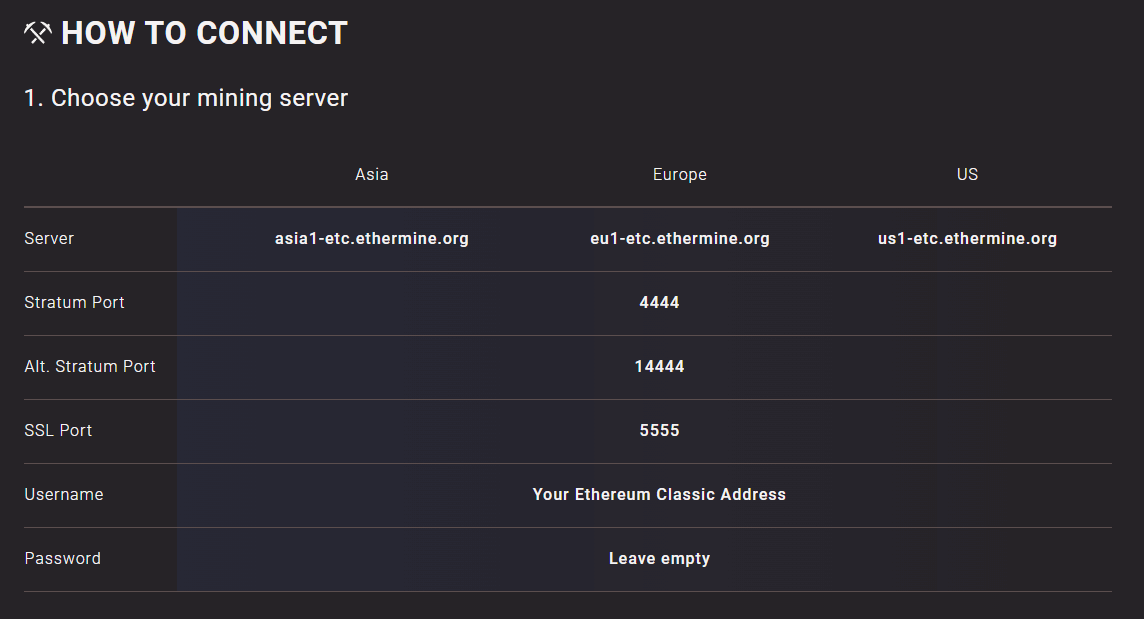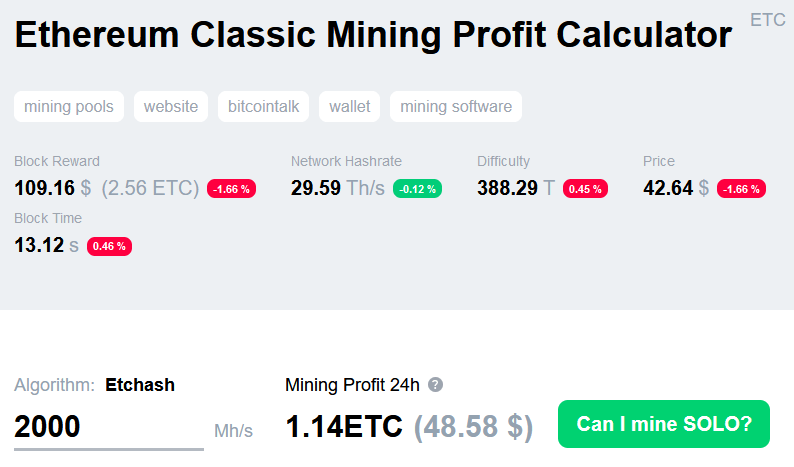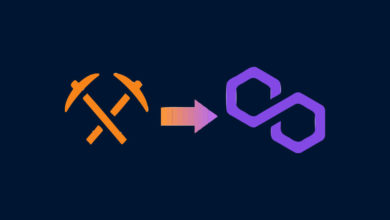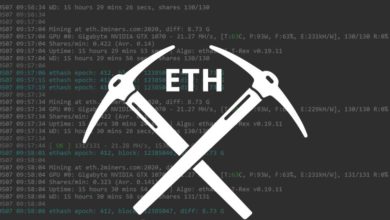How to mine Ethereum Classic? ETC Mining guide (AMD & NVIDIA)
Mining Ethereum Classic (ETC) could gain a massive traction as the main Ethereum network switches over from Proof-of-Work to its new Proof-of-Stake consensus mechanism. The Merge will make mining and miners obsolete on the ETH blockchain. This Ethereum networks upgrade will possibly impact earnings for millions of miners globally.
Ethereum miners with their PoW mining rig setups will be forced to relocate to other PoW blockchains. Most probably Post-Merge they’ll shift to Ethereum Classic (ETC) – An earlier fork of Ethereum which still uses the Proof-of-Work mechanism to secure its network. It could be one of the biggest beneficiary network after ETH 2.0 PoS.
Will Ethereum miners move over to Ethereum Classic post Merge? Vitalik Buterin and the Ethereum community believes that miners will move to Ethereum Classic network. Some miners on the other hand might gravitate to alternative PoW chains to mine coins. Some of the best PoW coins to GPU mine are Ravencoin, Bitcoin Gold, Ergo, Firo, Flux etc. Check out this list of GPU mineable coins.
We’ve covered mining guides for all the GPU coins except for Ethereum Classic. So here it is. A complete beginners guide on how to mine ETC Ethereum Classic in 2022. This article covers everything about mining Ethereum Classic. It guides you on how to mine ETC. It covers hardware requirement, mining softwares (miners), algorithm used by ETC and Ethereum Classic mining pools.
Ethereum Classic (ETC) has been around for a long time and is still one of the profitable coins to mine. While it is not as profitable as Ethereum mining it is still a good option for certain GPUs. Especially ETC is good on 4 GB cards. Also in the last few weeks Ethereum Classics price has rallied significantly. ETC has jumped from $14 to over $45, a 200% gain in just a month. So we just wanted to share the basic steps of getting started mining Ethereum Classic (ETC).
Now before we see Ethereum classic mining here is a little info about ETH merge and ETC.
ETH Merge – Ethereum 2.0 Proof of Stake
As you all know Ethereum mining is going away. It is set to move away from Proof-of-Work to less energy intensive Proof-of-Stake model and is one of the most important events in the crypto space. Instead of miners with powerful computers the network after the merge will be secured and operated by so called validators (stakers). This system is called Proof of Stake which has been rigorously tested and worked on for years.
Recently the Ethereum Goerli test network successfully merged to proof-of-stake. The third and final testnet merge went live on Goerli network. It is the final test run before the mainnet Merge goes live which is expected to take place mid September 2022. The Merge has been scheduled for TTD (Terminal Total Difficulty) 58750000000000000000000 which is approximately Sept 15 – 16th 2022.
ETH post merge may or may not be appealing for many. But miners are not happy with this move and ETH moving to PoS will definitely boost miners activity on other PoW network. Also there will be Ethereum Proof of Work (ETHPoW) hard fork after the merge but looks like many are not in favor of the fork. Massive projects like USDT, USDC and Chainlink have said no to ETH1 PoW fork and they will be supporting ETH PoS. If there is an ETH PoW fork then only miners will be mining and supporting the network. But they already have Ethereum Classic $ETC so it’ll be useless.
After the Ethereum’s “Merge” that is with imminent / recent switch to PoS, Ethereum Classic becomes the largest Proof-of-Work smart contract platform. Ethereum Classic has a long term commitment to PoW mining and it also inherits many of the previous Ethereum miners.
Is ETC the next best coin to mine after ETH 2.0?
Ethereum is the second largest crypto with a market value of over $200+ billion, which is half of Bitcoin’s market cap. The Ethereum chain features over 3000+ decentralized applications and has over $40+ billion sitting in the DeFi applications that lets users to trade, lend and borrow coins. Most of the popular NFTs (Non Fungible Tokens) such as crypto punks, BAYC are live there.
Ethereum Classic ETC also supports smart contracts and it provides a solid foundation to build decentralized applications. However it is not as successful nor it is as big as ETH smart contract ecosystem.
With Ethereum setting to move away from PoW mining which means it will be no longer be mineable. Ethereum Classic will be the only PoW smart contract platform that will remain mineable. Even Vitalik Buterin endorses ETC as a PoW EVM (Ethereum Virtual Machine). Many suspect that ETC will become the next best GPU mineable coin after the merge.
ETC is the only Proof-of-Work with smart contracts that is unstoppable and uncensorable. Not only miners will switch but we can also expect development flowing into ETC chain. Any Dapp that is running on ETH can be easily ported over to ETC. There is a bridge between ETH blockchain and ETC blockchain. Developers and users who wish to move tokens and projects between ETH and ETC chain can easily migrate.
Anyways currently according to mining calculators ETC is not so profitable to mine. However if you are planning to mine ETC in the future then mining it now will be more beneficial. Because post-merge all the ETH hash power moves over to ETC making it even less profitable to GPU mine.
Ethereum Classic – ETC
Here is a quick overview of Ethereum Classic for those who don’t know.
What is Ethereum Classic? Ethereum Classic (ETC) is a decentralized computing platform that allows anyone to build and use decentralized applications. The platform allows uncensorable smart contracts to be written, deployed and executed.
Ethereum Classic is a distributed network that consist of blockchain ledger and a robust ecosystem of on chain applications. It provides a permissionless way to manage digital assets without any intermediaries. ETC is a programmable money and the native cryptocurrency of the Ethereum Classic blockchain.
Ethereum Classic has been for a while. ETC is the original Ethereum and it is the original Ethereum blockchain. It is the unforked Ethereum blockchain – The continuation of unaltered Ethereum chain that didn’t undergo the hard fork in 2016 after the DAO hack, in which millions of ETH was stolen.
To know the history and information regarding the chain split and why they split. For Ethereum classic ETC history and to learn more about ETC check out their official website: https://ethereumclassic.org/
Now that Ethereum is moving closer to adopting Proof of stake, miners of Ethereum will hop on to Ethereum Classic. If you were mining ETH and got evicted out because of the consensus change then you can mine Ethereum Classic. This network welcomes and loves miners.
ETC Mining Pros
First of all Ethereum Classic mining is almost similar to mining Ethereum. While they don’t use the same PoW algorithm both ETC hash (Ethereum Classic’s hashing algorithm) and Ethash are quite similar. So it supports the same hardware and mining software. You can use your existing ETH mining rig to mine ETC. To start mining ETC all you have to do is simply switch over to a mining pool that supports Ethereum Classic ETC mining.
Here are some of the Pros of mining ETC: Supports GPU mining. You can easily mine Ethereum Classic just like you did mine Ethereum as they both use similar PoW. Ethereum Classic has a strong community of people with proof of work values and preferences. So it’ll continue to be mineable until all coins that is 210,700,000 ETC are released. Has a dedicated developer team and being one of the oldest PoW coins it is widely accepted and supported by major crypto exchanges, making it easy you to sell or trade for other currencies.
Note: This post is not a financial advise. Its just a mining guide showing you how to start mining Ethereum Classic. Do your own research and its totally up to you on whether you wish to mine it or not. You can mine it and sell it immediately or if you believe in its potentials then you can hold ETC in your wallet and cash out in the future at higher prices.
What is Ethereum Classic Mining?
Ethereum Classic is a PoW coin that relies on miners to secure its network. Mining is the most important element of Proof-of-Work cryptocurrencies. Ethereum Classic relies on mining just like BTC, DOGE and LTC that also utilizes PoW. Check out this list of proof-of-work mineable coins.
Mining is a process though which the network process blocks of transactions and adds them to the blockchain. Mining is a trustless decentralized mechanism that allows nodes to reach consensus and helps keep the network secure.
ETC being an decentralized open source platform no one single entity can have control over its ledger. Anybody in the world can take part in the network consensus without permission, can contribute hashpower and participate in the production of new ETC coins. This process is achieved via network of computers called miners.
Miners utilize their computing hash power to process transactions, validate blocks and to secure the network against double spend 51% attacks. In exchange for contributing their hashpower, providing the service and securing the blockchain miner whoever solves the block will be rewarded with ETC based on the block reward and transaction fees from the block.
Let’s look at the Ethereum Classic’s block reward, emission curve, issuance, inflation and limitations.
ETC mining block rewards / issuance / inflation
Ethereum has no supply cap. Ethereum Classic on the other hand voted to cap its max supply at 210,700,000 ETC. Meaning there will only be that amount of ETC coins in circulation ever. They adopted this monetary policy in December 2017. So for 65% of the coins has been mined that is 136,265,906.41 ETC and it is expected that mining will continue until approximately mid-2025.
ETC block time is 15 seconds that is on average newly created ETC coins come into circulation every 15 seconds. Also it has a reduction in block rewards similar to Bitcoin which cuts it reward by half every 4 years or 210,00 blocks. Ethereum Classic cuts it block rewards by 20% every 5,000,000 blocks. Previously the reward was reduced from 4 ETC to 3.2 ETC. During the last reduction at block height 15,000,000 the reward has been cut from 3.2 ETC to 2.56 ETC.
ETC also has mining difficulty adjustment that maintains and ensures that the block generation happens within the 15 second time limit. Difficulty increases as miners hash power increase and it adjusts down as miners reduce.
Let’s now look into the details on what type of hardware and software is best for Ethereum Classic mining.
ETCHash Algorithm
The best hardware for mining Ethereum Classic currently is GPU. Initially Ethereum Classic used the Ethereum’s Ethash hashing algorithm. The problem with Ethash is ASIC miners. The development and rise of Ethash ASIC along with the hash power rental service like NiceHash has given advantage for some bad actors to execute double spend attacks. Its easy for anyone to rent hash power from NiceHash and mine ETC.
In 2019 and 2020 when Ethereum Classic’s total network hashrate was too low bad actors took control over the network and executed double spend attacks. So far ETC has suffered two 51% attacks.
To avoid any further attacks from ASIC farms and hash power rental service ETC developers tweaked the Ethash algorithm and introduced ETCHash. Not only that but in 2020 Ethereum’s DAG also exceeded 4 GB making GPUs with less than 4 GB unable to mine. To make it more miner friendly In late 2020 during the Thanos hard fork (ECIP-1099) upgrade at block 11,700,000 ETC changed their mining algorithm from Ethash to ETChash. It decreased size of the ETC network’s DAG file making GPUs with less than 4 GB continue to mine ETC.
ETC mining algorithm ETChash is similar to Ethash still but it ensures that cards with 4 GB and lesser (3 or 4 GB RAM) would be able to mine ETC. It also guards specialized ASIC equipment from mining the chain. And it also resists hashpower rental service like NiceHash. Miners will not be able to rent hashpower from external source to mine ETC.
Other than ETChash the project also once introduced ECIP 1095: To change the ETC Proof of Work algorithm to SHA-3-256 (vanilla Sha-3). But that proposal was later canceled and rejected.
Alright! Now that we know enough about ETC and ETChash let’s get started mining Ethereum Classic.
How to mine Ethereum Classic (ETC)? ETChash
Mining ETC is same as mining any other PoW mineable coins. 1. Get a suitable mining hardware. 2. Get your wallet. 3. Install a mining software. 4. configure the miner and start mining.
To get started with Ethereum Classic mining you first need a suitable hardware. So let’s look at the mining hardware first. What kind of hardware equipment is best to use for mining ETC?
ETC mining hardware
ETChash is the standard Proof of Work algorithm for Ethereum Classic. To mine Ethereum Classic effectively you need an efficient mining hardware that produces higher hashrate. While ETCHash is a slightly modified version of Ethash which was designed to resist ASIC in the first place it does not completely resist them.
Currently there are two main types of hardware that can be used to mine Ethereum Classic. ETC can be efficiently mined with GPU as well as ASIC mining machines. CPUs are obsolete.
1. GPUs:
Right now the most popular way to mine Ethereum Classic is with GPUs. You can use both NVIDIA and AMD graphic cards. If you were mining ETH previously then you can use your ETH rig which also produces better hashrates on ETC.
Generally, the most power efficient cards such as NVIDIA RTX 3060Ti, RTX 3070, RTX 2070, GeForce GTX 1080, and GTX 1080 Ti are best graphics cards to mine Ethereum Classic. For AMD you got Radeon VII that hashes up to 105 MH/s. You can use Rx 6900 XT, 6800 XT, 6700 XT, Rx 6600 XT, Rx 5700 etc.
Other than high end graphic cards you can also effectively mine with 4Gb cards. Since the DAG size is decreased ETC can also be mined with 4 GB cards. In fact GPUs with 4 GB of memory does well at mining ETC. But make sure your GPU has a minimum of 4GB RAM.
2. ASICs:
Application Specific Integrated Circuits – A range of ETChash ASIC miners are also available for Ethereum Classic mining. Just give it a search online for “ETC ASIC Miners”.
With that said this guide only covers GPU mining. Also we highly do not recommend investing thousands and buying GPUs and ASICs for mining at this time. You strictly won’t make your ROI.
ETC wallet address
Once you have the right mining equipment you need to obtain a wallet address. You’ll need an ETC address to receive mining payouts from the pool.
Get yourself a wallet to safely store your mined Ethereum Classic coins. There are several secure wallet options to choose from. You an use software wallets such as Exodus, Coinomi, Jaxx, Cobo wallet and Trust wallet. You can use web wallets such as MyCrypto and MyEtherWallet. Also you can use browser based wallets such as Brave wallet and Metamask. All you have to do is connect your Metamask extension to Ethereum Classic network. If you own Ledger or Trezor hardware wallet then you can also use that to store your ETC tokens.
If you’ll be mining and selling immediately then you can use your Exchange wallet ETC address. You can send your mining payouts to exchanges such as Binance or Huobi.
Note: Always do your own diligence when choosing an exchange or a wallet provider. Choose the one that best suits your needs.
For a full list of wallets check out this page: https://ethereumclassic.org/services/wallets
ETChash mining software
You can use any of the popular GPU miners to mine ETC. All the Ethereum miners supports ETC mining. You have popular options like GMiner, NBMiner, lolMiner, Phoenix miner and Nanominer which all supports both AMD and NVIDIA cards and they are available for both Windows as well as Linux.
For AMD cards specifically you can use the Team Red Miner which is available for both Window and Linux. Likewise for NVIDIA cards you can use the T-Rex miner which is also available for Windows and Linux.
If you are using Linux then the following OS also supports ETC mining: Hive OS, NiceHash OS, Simple Mining OS, Awesome Miner and Rave OS.
There are several software options for ETC miners and here you can find a complete list of miners that can be used to mine ETC on various operating systems: https://ethereumclassic.org/mining/software. Here you’ll also find the download links for the miners.
Downloading the miner software
You can download any miner of your choice but here in this guide we’ll only be showing settings for the following miners: T-Rex, Team Red Miner, lolMiner, GMiner and NBMiner.
Before you download the miner ensure that it supports your GPU and works on your chosen operating system.
Note: While downloading your browser might block the miner file. Also after downloading your antivirus program might remove the miner from your PC. Just add exclusion and continue with the download.
After you have the miner ready you need to uncompress and configure it. Before we configure the mining software let’s choose a mining pool.
Ethereum Classic mining pools
Once you have the mining software ready its time to join a mining pool. Why mining pool and why not solo? Successful mining totally depends on your hashpower. The higher it is the greater the chances of winning the block reward. With high network hashrate we do not recommend solo mining ETC as you’ll find it difficult to compete against mining pools and large mining farms. The best way to mine ETC is by joining a mining pool.
A mining pools is where a group of individual miners join together and combine their computing hash power to strengthen the probability of finding a block and successfully mine ETC. The share of mining rewards is distributed to all the miners of the pool proportional to the computational power they contributed.
More the hashrate you contribute to the pool the more your rewards will be. For example if you contribute 5% of the total pool hashrate, you’ll receive a payout of 5% of the 2.56 ETC block rewards that the pool wins. Plus the transaction fees from the block only if the mining pool also shares the blocks transaction fees to its miners.
Mining pools charge a certain percentage of fees from your profits and different pools have different reward structure and payout plans. Check out PPS vs PPLNS. Understanding factors like mining difficulty, hashrate is important before you start. Also when looking for a mining pool consider the following: Total network hashrate vs pools total hashrate, server locations, pool fees and number of active miners.
Some of the popular mining pools that you can consider for ETC mining are: Ethermine.org, 2Miners.com, f2pool, Hiveon pool for Hive OS users and Nanopool. There are other pools like Miningpoolhub, Flexpool which you can also consider.
The following page contains the list of mining pools that support Ethereum Classic mining: https://miningpoolstats.stream/ethereumclassic
To earn regular mining rewards join an effective and reputable mining pool. Here we’ve explained how to choose the best mining pool. Most importantly ensure that the pool has decent amount of miners and hashrate so you get frequent payouts. Also if the pool has more than 40% of total network hashrate then consider joining a different pool to help decentralization.
Currently, Ethereum Classic’s total network hashrate stands at 30 Th/s. A few weeks ago it was less than 7 Th/s and the hashrate only keeps increasing. Looks like as the main Ethereum blockchain abandons PoW miners more number of miners are joining the ETC network.
Configuring mining software
For NVIDIA GPUs we recommend T-Rex or GMiner. For AMD GPUs we recommend lolMiner or GMiner. Anyways below we’ve shared the configuration settings for all the following miners: T-Rex, Team Red Miner, lolMiner, GMiner and NBMiner. Also here we’ll be using 2 miners and Ethermine as an example. However the configuration setting is same for all the mining pools. You only have to change the server connection details which is shown on the mining pool page.


After you have downloaded your chosen mining software, unzip the file. Within the miner folder you’ll find start.bat or etc.bat or start.cmd file. In GMiner its mine-etc.bat and in T-Rex miner its ETC-2miners.bat. The name of the sample batch file varies for each miners.


Right click the existing ETC batch file and click edit. Replace its commands with the commands that you see below. Make sure to use the one that corresponds to your chosen mining software.
Software commands:
Gminer 2Miners:
miner.exe --algo etchash --server etc.2miners.com:1010 --user YOUR_WALLET_ADDRESS.x pause
GMiner Ethermine:
miner.exe --algo etchash --server eu1-etc.ethermine.org:4444 --user YOUR_WALLET_ADDRESS.x Pause
T-Rex 2 Miners:
t-rex.exe -a etchash -o stratum+tcp://etc.2miners.com:1010 -u YOUR_WALLET_ADDRESS -w RIG_ID -p x pause
T-Rex Ethermine:
t-rex.exe -a etchash -o stratum+tcp://eu1-etc.ethermine.org:4444 -u YOUR_WALLET_ADDRESS -w RIG_ID -p x pause
NBMiner 2 Miners:
nbminer.exe -a etchash -o stratum+tcp://etc.2miners.com:1010 -u YOUR_WALLET_ADDRESS.RIG_ID pause
NBMiner Ethermine:
nbminer.exe -a etchash -o stratum+tcp://eu1-etc.ethermine.org:4444 -u YOUR_WALLET_ADDRESS.RIG_ID pause
lolMiner 2Miners:
lolMiner.exe --algo ETCHASH --pool etc.2miners.com:1010 --user YOUR_WALLET_ADDRESS.RIG_ID Pause
lolMiner Ethermine:
lolMiner.exe --algo ETCHASH --pool eu1-etc.ethermine.org:4444 --user YOUR_WALLET_ADDRESS.RIG_ID pause
TeamRedMiner 2Miners:
teamredminer.exe -a ethash -o stratum+tcp://etc.2miners.com:1010 -u YOUR_WALLET_ADDRESS.RIG_ID -p x pause
TeamRedMiner Ethermine:
teamredminer.exe -a ethash -o stratum+tcp://eu1-etc.ethermine.org:4444 -u YOUR_WALLET_ADDRESS.RIG_ID -p x pause
In the configuration settings you are adding your pool address and your wallet address to which you’ll receive your mining rewards.
For example if you are using T-Rex miner and wish to mine on 2Miners then use the T-Rex 2miners setting. Make sure to replace the wallet address with your Ethereum classic address. You can also change the server location that is closer to you. The final configuration should look like this.
t-rex.exe -a etchash -o stratum+tcp://etc.2miners.com:1010 -u 0xEf9AAb0e49FCE5cFfA858c1935558cec6601357E -w RIG_ID -p x pause
Note: In the above config we’ve used our ETC address. Replace it with your ETC address.
That’s it! Once the configuration is ready, save the file and close it. Then double click the edited .bat file to start mining Ethereum Classic.
Congrats! You’re now mining Ethereum Classic.

Mining statistics and rewards
Once your machine starts to mine wait for the miner to submit shares. After you see hashrate submitted successfully message go to your mining pool and enter your ETC wallet address. As long as you’re hashrates are being submitted successfully, you will receive payouts from the mining pool.
To view your real time Ethereum classic mining rewards, to check your hashrate and mining statistics visit the pool page. On the pool dashboard enter your ETC wallet address and hit enter. The pool dashboard will display your complete mining statistics.
That’s it! Now all you have to do is wait for pool to payout to your ETC address. Note: The minimum payout threshold varies from pool to pool and you have to wait for the payout until you reach the minimum threshold.
Ethereum Classic Calculator
Once you get to know your mining hashrate you can estimate your ETC mining rewards and profits. To estimate earnings, costs, and profits for mining ETC you can use any of the following Ethereum Classic mining profit calculator.
https://www.coinwarz.com/mining/ethereum-classic/calculator
https://minerstat.com/coin/ETC
https://2cryptocalc.com/etc-mining-calculator
All these Ethereum Classic calculators are constantly updated with the network and they’re preloaded with the following info: current block mining information, network hashrate, electricity costs (I.e. $0.10 per kWh) and difficulty.
You just have to enter your Ethereum Classic mining hashrate, your hardware’s power consumption in watts and the pool maintenance fees. Based on your hashrate, network difficulty, power consumption, coin price and costs it’ll calculate how much ETC you’ll mine and how much profits in $ you’ll earn from mining ETC.
Mining Ethereum Classic can be profitable if you are using the right hardware that good enough hashrate. Since ETChash consumes less power a robust gaming laptop can be suitable for mining ETC.
How long does it take to mine 1 ETC?
Hashrate needed to mine 1 Ethereum Classic? At the time of writing and at current difficulty level, with 2000/MHs one can mine slightly more than 1 ETC per day.

The current Ethereum Classic’s network hashrate is at 30 TH/s. After ETH 2.0 when Ethereum miners turn to ETC, the network hashrate could see significant growth.
That’s all! We hope we’ve covered everything regarding how to mine Ethereum Classic. If you got any questions about mining or if you run into any problems there is an active mining channel in the Ethereum Classic Discord; https://ethereumclassic.org/community/channels. Seek help from the community.




